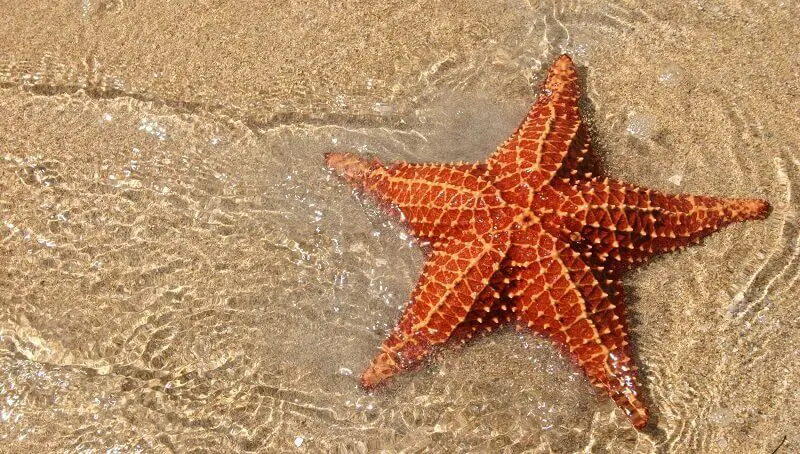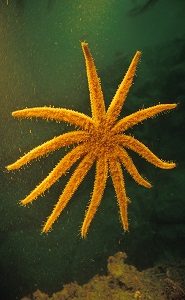
What do Giraffes Eat?
November 8, 2022
Snake Repellent: How to Keep Snakes Away
November 8, 2022
The starfish or the sea star belongs to the class of Asteroidea. It is also called the fragile star. There are 2000 species that live in all the world’s oceans: The Pacific, Atlantic, Indian, Arctic, and South Ocean (Antarctica).
Sea stars are found at various depths, some larger than 6000m. They are the most familiar marine animals and possess a number of well-known traits, such as regeneration and feeding on mussels.
They vary according to individual species and possess a great diversity of forms and ways of feeding.
What does a starfish eat?
The digestive system is quite complicated. The mouth is located on the lower part of the body and opens through a short esophagus.
First, it opens the clam. Then it pulls its stomach out of its mouth and inserts it between the clam valves. The stomach secretes enzymes with the help of which it digests the victim.
Because of its ability to digest food outside of its body, the starfish is able to hunt prey larger than its mouth, such as clams, oysters, arthropods, small fish, and mollusks. The sea star feeds mostly on clams.
Not all species are carnivores or just carnivores. In the absence of meat, they can supplement their diet with algae.
A starfish doesn’t always have 5 arms
The starfish expresses at maturity a pentaradial symmetry. However, it is believed that the ancestors had bilateral symmetry. The most common star has 5 rays or arms. There are also species with 6 or more arms due to developmental anomalies.
You might also like my articles with interesting facts about piranha fish, the narwhal, or the manatee.
Other species simply have several. For example, the species Solasteridae can have up to 50 arms. These organisms are composed of calcium carbonate. The bottom surface contains the oral surface and the upper surface is harder. It also has a protective role.
How does a starfish move?
From the surface of the body, several structures can be identified that comprise the basic anatomy of these animals and can sometimes help identify it. The 5 arms move on dozens of legs. Tubular feet move when water is pumped through them in and out.
A system of channels leads water to the feet. There are some pumps on these channels. They regulate the circulation of water. The sea star absorbs water through a filter.
At the end of each arm, there is a microscopic eye with which the starfish can see where it is moving in light and in darkness. There is no cornea or iris.
Starfish breathing
Breathing occurs mainly through tubes from small arms called papillae. In this way, the oxygen from water is distributed throughout the body. Excretion also occurs through this system of tubes and papillae.
Starfish have no blood
 Instead of blood, starfish have a circulatory system consisting mainly of seawater.
Instead of blood, starfish have a circulatory system consisting mainly of seawater.
Seawater is pumped into the animal’s water vascular system through the sieve plate. This is a kind of trap door called the madreporite, which is often visible as a light-colored spot on the top of the star.
From the madreporite, seawater moves into the legs of the sea tube and thus extends an arm. The muscles in the legs of the tube are used to retract the limb.
Starfish can reproduce sexually or asexual
Most species are hermaphrodites. One species is born a male and later turns into a female.
Sexual dimorphism cannot be seen from the outside. Eggs after being laid only need to be covered and hatched. Sea stars gather during the reproduction period and it is not known how they communicate but multiply all on the same day.
One species reaches reproductory maturity in 2 years and lives about 10 years. Other species reach maturity in 5 years and live 30-40 years.
A starfish has the ability to regenerate
If an arm is broken, it regenerates only if at one end it has a part of the central disc, that is, only the part trapped by the body. Life span varies between species, larger species live longer.
Starfish facts!
- The starfish has no brain.
- The starfish is a very special animal. It has the shape of a star and lives in water but is not a fish, although it is called starfish.
- Starfish have photosensitive cells at the end of each arm, which make up a kind of primitive eye, capable of reacting to light. However, they do not see very well, in detail. They can only distinguish light and darkness.
- Most of them have 5 arms, but there are species that have 12, 24, or even 50 arms.
- Like other sea creatures, starfish have the ability to regenerate their lost arms. Some species can even regenerate their entire body, starting from a single remaining arm. If attacked, some species may pull off one of their arms to escape.
- When we think of starfish, we imagine them as small animals, which we can hold in the palm of our hands, but there are starfish that can reach up to 1 meter.
- According to National Geographic, there are about 2000 species of starfish out there. They come in a wide variety of colors, sizes, number of arms, or with different textures.
- They are carnivorous animals, most often feeding on oysters, mollusks, or snails.
- They move using small tubular legs, (small cupping legs), which are attached to their arms.
- Some species live up to 5 years, while others can live up to 30 years.
- Often mislabeled as fish, starfish belong to the group of invertebrates, animals that do not have a backbone. Fish are vertebrate animals, meaning they have a backbone.
- Many types of toxins have been extracted from different species of starfish for research and pharmaceutical or industrial fields worldwide.
